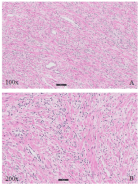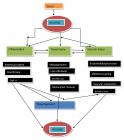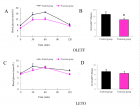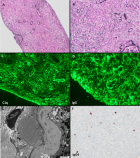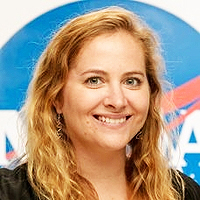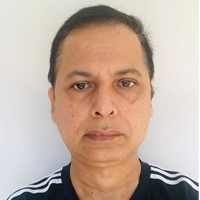Abstract
Research Article
Neuroanatomical profile of hemineglect in patient’s body image modification
Maurizio Falso* and Eleonora Cattaneo Psy
Published: 26 March, 2020 | Volume 4 - Issue 1 | Pages: 001-008
Background: NSU is generally caused by right cerebral hemisphere lesions with a preeminent localization on the frontoparietal lobe.
Aim: To assess the correlation between the typology and the brain lesion site and the consensual consent modality of body image modification after an integrated rehabilitative and neuropsychological treatment.
Setting: A rehabilitation institute for the treatment of neurological gait disorders and neuropsichological failures.
methods: Patients recruited were divided according to the brain lesion site into 3 groups (IG = ischemic group = 5 patients; HG = hemorrhagic group = 4 patients; IG + HG = ischemic + hemorrhagic group = 3 patients) based on CT brain performed in the post-acute phase. At time T0, the patients recruited underwent a systematic review of their current neuroradiological profile (location delineation and type of brain injury) compared with a consensual framing of the neuromotor and neuropsychological profile acquired at the time of taking charge in the ward. At time T1 and after the drafting and implementation of the rehabilitation treatment plan foreseen in the study (1 to 4 months after T0), the patients in our sample underwent a re-evaluation of their neuromotor and neuropsychological profile with controls of the same outcome parameters considered at time T0.
Results: A parametrically but not statistically significant modification of the results obtained was observed by measuring the MI ULl, MI LLl and TCT scales in the group with hemorrhagic brain injury; the analysis of variance did not show any statistical significance in the relationship between the type of stroke (ischemic, hemorrhagic or both) and the motor impairment passing from time T0 to time T1. The analysis of variance did not reveal a statistically or parametrically significant relationship between the type (ischemic, hemorrhagic and ischemic + hemorrhagic) of cerebral stroke and the variations of the neuropsychological profile. The T-Student test showed statistically significant changes in the importance of the lesion site in defining the degree of motor disability. In particular, we observed, about the presence of frontal lobe lesions, a statistically significant variation passing from the T0 time to the T1 time for the following motor scales in 9 of 12 recruited patients: MI LLl (26.4 vs. 62, with p < 0.05), TCT (43.6 vs. 80.6, with p < 0.01 for equal variance assumed and p < 0.05 for equal variance not assumed), FAC (0.8 vs. 2.3 with p < 0,01 for equal variance assumed and p < 0.05 for equal variance not assumed).
Conclusion: We have confirmed the importance of the anatomical-dysfunctional correlation as a key concept from which to start in any neurorehabilitative treatment approach. Our work has highlighted the basic role of the right frontal lobe in the programming and execution of the gesture and its kinesthetic control as regards the left lower limb and the trunk.
Read Full Article HTML DOI: 10.29328/journal.jnpr.1001029 Cite this Article Read Full Article PDF
Keywords:
NSU; Body schema; Rehabilitative treatment of NSU
References
- Blanke O. I and me: self-potraiture in brain damage. Front Neurol Neurosci. 2007; 22: 14-29.Pubmed: https://www.ncbi.nlm.nih.gov/pubmed/17495503
- Gallagher S, Cole J. Body schema and body image in a deafferented subject. J Mind Behaviour. 1995; 16: 369-390.
- Shildler P. The image and appearance of the human body. 1935. Routledge. London.
- Maravita A, Iriki A. Tools for the body (schema). Trends Cogn Sci. 2004; 8:79-86. Pubmed: https://www.ncbi.nlm.nih.gov/pubmed/15588812
- Berlucchi G, Aglioti S. The body in the brain: neural bases of corporeal awareness. Trends Neurosci. 1997; 20: 560-564. Pubmed: https://www.ncbi.nlm.nih.gov/pubmed/9416668
- Maravita A, Spence C, Driver J. Multisensory integration and the body schema: close to hand and within reach. Current Biology. 2003; 13: R531-539. Pubmed: https://www.ncbi.nlm.nih.gov/pubmed/12842033
- Coslett HB, Saffran EM, Schwoebel J. Knowledge of the human body: a distinct semantic domain. Neurology. 2002; 59: 357-363. Pubmed: https://www.ncbi.nlm.nih.gov/pubmed/12177368
- Jeannerod M, Biguer B. Egocentric reference and represented space. Revue Neurologique (Paris). 1989; 145: 635-639. Pubmed: https://www.ncbi.nlm.nih.gov/pubmed/2682938
- He BJ, Shulman GL, Snyder AZ, Corbetta M. The role of impaired neuronal communication in neurological disorders. Curr Opin Neurol. 2007; 20: 655-660. Pubmed: https://www.ncbi.nlm.nih.gov/pubmed/17992085
- Ptak R, Schnider A. The attention network of the human brain: relating structural damage associated with spatial neglect to functional imaging correlates of spatial attention. Neuropsychologia. 2011; 49: 3063-3070. Pubmed: https://www.ncbi.nlm.nih.gov/pubmed/21787795
- Starkstein SE, Fedoroff JP, Price TR, Leiguarda R, Robinson RG. Anosognosia in patients with cerebrovascular lesions. A study of causative factors. Stroke. 1992; 23:1446-1453. Pubmed: https://www.ncbi.nlm.nih.gov/pubmed/1412582
- Maeshima S, Truman G, Smith DS, Dohi N, Nakai K, et al. Is unilateral spatial neglect a single phenomenon? J Neurol. 1997; 224:412-417. Pubmed: https://www.ncbi.nlm.nih.gov/pubmed/9266458
- Evyapan D, Kumral E. Pontine anosognosia for hemiplegia. Neurology. 1999; 3: 647-649. Pubmed: https://www.ncbi.nlm.nih.gov/pubmed/10449140
- Pia L, Neppi-Modona N, Ricci R, Berti A. The anatomy of anosognosia for hemiplegia: a meta-analysis. Cortex. 2004; 40: 367-377. Pubmed: https://www.ncbi.nlm.nih.gov/pubmed/15156794
- Berti A, Bottini G, Gandola M, Pia L, Smania N, et al. Shared cortical anatomy for motor awareness and motor control. Science. 2005; 309: 488-491. Pubmed: https://www.ncbi.nlm.nih.gov/pubmed/16020740
- Karnath HO, Baier B, Naegele T. Awareness of the functioning of one’s own limbs mediated by insular cortex? J Neurosci. 2005; 25: 7134-7138. Pubmed: https://www.ncbi.nlm.nih.gov/pubmed/16079395
- Jourdan S, Torres C, Agostino F, Chiapolini S, Morin L, et al. Effets de la reeducation sur l’héminégligence. Kinésithérapie. 2010; 107: 28-33.
- Luauté J, Schwartz S, Rossetti Y, Spiridon M, Rode G, et al. Dynamic changes in brain activity during prism adaptation. J Neurosci. 2009; 29: 169-178. Pubmed: https://www.ncbi.nlm.nih.gov/pubmed/19129395
- Buxbaum LJ, Ferraro MK, Veraminti T, Farné A, Whyte J, et al. Hemispatial neglect-subtypes, neuroanatomy and disability. Neurology. 2004; 62:749-756. Pubmed: https://www.ncbi.nlm.nih.gov/pubmed/15007125
- Paolucci S, Antonucci G, Grasso MG, Bragoni M, Coiro P, et al. Functional outcome of ischemic and hemorrhagic stroke patients after inpatient rehabilitation – a matched comparison. Stroke. 2003; 34: 2861-2865. Pubmed: https://www.ncbi.nlm.nih.gov/pubmed/14615613
- Lauretani F, Saccavini M, Zaccaria B, Agosti M, Zampolini M, et al. Rehabilitation in patients affected by different types of stroke. A one-year follow-up study. Eur J Phys Rehabil Med. 2010; 46: 511-517. Pubmed: https://www.ncbi.nlm.nih.gov/pubmed/20414185
- Lipson DM, Sangha H, Foley NC, Bhogal S, Pohani G, et al. Recovery from stroke: differences between subtypes. Int J Rehabil Res. 2005; 28: 303-308. Pubmed: https://www.ncbi.nlm.nih.gov/pubmed/16319555
- Chwen-Yng S, Jyh-Jong C, Hui-Mei C, Chin-Jung S, Tsui-Hsien C, et al. Perceptual differences between stroke patients with cerebral infarction and intracerebral hemorrhage. Arch Phys Med Rehabil. 2000; 81: 706-714. Pubmed: https://www.ncbi.nlm.nih.gov/pubmed/10857510
- Bottini G, Sterzi R, Vallar G. Directional hypokinesia in spatial hemineglect: a case study. J Neurol Neurosurg Psychiatry. 1992; 55: 562-565. Pubmed: https://www.ncbi.nlm.nih.gov/pmc/articles/PMC489166/
- Sapir A, Kaplan JB, He BJ, Corbetta M. Anatomical correlates of directional hypokinesia in patients with hemispatial neglect. J Neurosci. 2007; 15: 4045-4051. Pubmed: https://www.ncbi.nlm.nih.gov/pubmed/17428982
- Heilman KM, Bowers D, Coslett HB, Whelan H, Watson RT. Directional hypokinesia: prolonged reaction times for leftward movements in patients with right hemisphere lesions and neglect. Neurology. 1985; 35: 855-859. Pubmed: https://www.ncbi.nlm.nih.gov/pubmed/4000486
Figures:

Figure 1

Figure 2

Figure 3

Figure 4
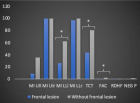
Figure 5

Figure 6

Figure 7

Figure 8

Figure 9

Figure 10
Similar Articles
-
Rehabilitation of proximal humerus fractures: An environmental scan of Canadian physiotherapy practice patternsLowell L Kwan,Norma J MacIntyre*. Rehabilitation of proximal humerus fractures: An environmental scan of Canadian physiotherapy practice patterns. . 2017 doi: 10.29328/journal.jnpr.1001013; 1: 104-119
-
Influence of an integrated rehabilitative treatment on the modification of body representation in patients affected by Unilateral Spatial NeglectMaurizio Falso*,Michela Delpero,Eleonora Cattaneo. Influence of an integrated rehabilitative treatment on the modification of body representation in patients affected by Unilateral Spatial Neglect. . 2018 doi: 10.29328/journal.jnpr.1001023; 2: 087-100
-
A trial of conservative care for restoring scapular dyskinesis: A clinical seriesS Thiruvarangan*,P Srigrishna,B Thileebphan. A trial of conservative care for restoring scapular dyskinesis: A clinical series. . 2020 doi: 10.29328/journal.jnpr.1001031; 4: 011-015
-
Contemporary learning or E-Learning in physiotherapy, pre and post COVID-19: Short communicationMohammed Suhail*,Sharath C,Akhil Mathew. Contemporary learning or E-Learning in physiotherapy, pre and post COVID-19: Short communication. . 2020 doi: 10.29328/journal.jnpr.1001030; 4: 009-010
-
Neuroanatomical profile of hemineglect in patient’s body image modificationMaurizio Falso*,Eleonora Cattaneo Psy. Neuroanatomical profile of hemineglect in patient’s body image modification. . 2020 doi: 10.29328/journal.jnpr.1001029; 4: 001-008
-
The real-time information provision problem in assessing rehabilitation needs among athletes with overtraining syndromePanagiotis Katrakazas. The real-time information provision problem in assessing rehabilitation needs among athletes with overtraining syndrome. . 2022 doi: 10.29328/journal.jnpr.1001044; 6: 009-010
-
Assessment and treatment of patients with kinesiophobia: A Delphi consensusMattias Santi*,Ina Diener,Rob Oostendorp. Assessment and treatment of patients with kinesiophobia: A Delphi consensus. . 2022 doi: 10.29328/journal.jnpr.1001047; 6: 023-028
-
Physiotherapy Can Help Recover Functional Status in Community-dwelling Seniors Assessed in Emergency Departments for Minor InjuriesLaurence Fruteau de Lacos, Andréanne Blanchette, Kadija Perreault, Raoul Daoust, Jacques Lee, Jeffrey J Perry, Marcel Émond, Eddy Lang, Nathalie Veillette and Marie-Josée Sirois*. Physiotherapy Can Help Recover Functional Status in Community-dwelling Seniors Assessed in Emergency Departments for Minor Injuries. . 2023 doi: 10.29328/journal.jnpr.1001052; 7: 022-028
-
Cardiovascular Response to Head Down Crooked Kneeling Position Among Type 2 Diabetic PatientSumbal Javed, Muhammad Faizan Hamid*, Ahsan Javed, Javaria Azeem, Jawad Ahmad, Eeraj Chaudhry. Cardiovascular Response to Head Down Crooked Kneeling Position Among Type 2 Diabetic Patient. . 2023 doi: 10.29328/journal.jnpr.1001054; 7: 035-038
Recently Viewed
-
Leiomyosarcoma in pregnancy: Incidental finding during routine caesarean sectionToon Wen Tang*,Phoon Wai Leng Jessie. Leiomyosarcoma in pregnancy: Incidental finding during routine caesarean section. Clin J Obstet Gynecol. 2021: doi: 10.29328/journal.cjog.1001094; 4: 092-095
-
Adult Neurogenesis: A Review of Current Perspectives and Implications for Neuroscience ResearchAlex, Gideon S*,Olanrewaju Oluwaseun Oke,Joy Wilberforce Ekokojde,Tolulope Judah Gbayisomore,Martina C. Anene-Ogbe,Farounbi Glory,Joshua Ayodele Yusuf. Adult Neurogenesis: A Review of Current Perspectives and Implications for Neuroscience Research. J Neurosci Neurol Disord. 2024: doi: 10.29328/journal.jnnd.1001102; 8: 106-114
-
Late discover of a traumatic cardiac injury: Case reportBenlafqih C,Bouhdadi H*,Bakkali A,Rhissassi J,Sayah R,Laaroussi M. Late discover of a traumatic cardiac injury: Case report. J Cardiol Cardiovasc Med. 2019: doi: 10.29328/journal.jccm.1001048; 4: 100-102
-
A two-phase sonographic study among women with infertility who first had normal sonographic findingsKalu Ochie*,Abraham John C. A two-phase sonographic study among women with infertility who first had normal sonographic findings. Clin J Obstet Gynecol. 2022: doi: 10.29328/journal.cjog.1001117; 5: 101-103
-
Sinonasal Myxoma Extending into the Orbit in a 4-Year Old: A Case PresentationJulian A Purrinos*, Ramzi Younis. Sinonasal Myxoma Extending into the Orbit in a 4-Year Old: A Case Presentation. Arch Case Rep. 2024: doi: 10.29328/journal.acr.1001099; 8: 075-077
Most Viewed
-
Evaluation of Biostimulants Based on Recovered Protein Hydrolysates from Animal By-products as Plant Growth EnhancersH Pérez-Aguilar*, M Lacruz-Asaro, F Arán-Ais. Evaluation of Biostimulants Based on Recovered Protein Hydrolysates from Animal By-products as Plant Growth Enhancers. J Plant Sci Phytopathol. 2023 doi: 10.29328/journal.jpsp.1001104; 7: 042-047
-
Sinonasal Myxoma Extending into the Orbit in a 4-Year Old: A Case PresentationJulian A Purrinos*, Ramzi Younis. Sinonasal Myxoma Extending into the Orbit in a 4-Year Old: A Case Presentation. Arch Case Rep. 2024 doi: 10.29328/journal.acr.1001099; 8: 075-077
-
Feasibility study of magnetic sensing for detecting single-neuron action potentialsDenis Tonini,Kai Wu,Renata Saha,Jian-Ping Wang*. Feasibility study of magnetic sensing for detecting single-neuron action potentials. Ann Biomed Sci Eng. 2022 doi: 10.29328/journal.abse.1001018; 6: 019-029
-
Pediatric Dysgerminoma: Unveiling a Rare Ovarian TumorFaten Limaiem*, Khalil Saffar, Ahmed Halouani. Pediatric Dysgerminoma: Unveiling a Rare Ovarian Tumor. Arch Case Rep. 2024 doi: 10.29328/journal.acr.1001087; 8: 010-013
-
Physical activity can change the physiological and psychological circumstances during COVID-19 pandemic: A narrative reviewKhashayar Maroufi*. Physical activity can change the physiological and psychological circumstances during COVID-19 pandemic: A narrative review. J Sports Med Ther. 2021 doi: 10.29328/journal.jsmt.1001051; 6: 001-007

HSPI: We're glad you're here. Please click "create a new Query" if you are a new visitor to our website and need further information from us.
If you are already a member of our network and need to keep track of any developments regarding a question you have already submitted, click "take me to my Query."






